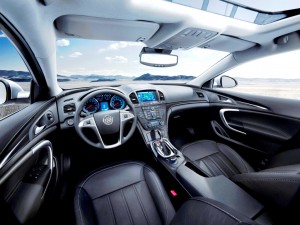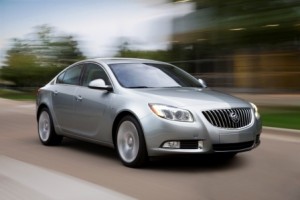Buick is taking an Opel Insignia sport sedan, adding the existing Chinese grille and Regal badges and bringing it to America during the second quarter of next year.
For the first 15 months of sale, Regal will be imported from Rüsselsheim, Germany, before a yet unspecified North American assembly site comes on stream.
There are no plans to import the Regal from China, where it is also currently made, with more than 64,000 in sales since production started last December.
Later today in Los Angeles, an estimated 600 Buick owners and potential customers culled from German and Japanese sport sedan owners will have the chance to test-drive the top of the line CXL versions of the mid-size car.
The last time Buick tried this with a rebadged Saturn hybrid, reaction was so negative that Buick canceled the program it had just announced a fortnight or so before.
This time around – “kissing the dragon,” marketing slang for talking to breathing customers instead of idealized, fictional ones – might not be so bad since the Opel is universally acclaimed as a solid product.
So out in la-la land where GM is a mere footnote to sales tables, “intenders” will get a shot at the performance-oriented, front-wheel-drive CXL. They will test, what could be weeks or months ahead of the media, a sport model with an optional 2-liter, direct injected four-cylinder engine that is said to provide more power than Japanese V6 engines in competitors.
Preliminary ratings here of 220 horsepower (164 kW) and 258 pound feet of torque should make this CSX a mid-seven-second zero-to-6o mph car. The 2.0L turbo uses a twin-scroll turbocharger that is said to build power quickly at lower rpms. Would they dare badge it Gran Sport, nailhead fans?
All these assertions await test drives to prove their veracity. However, previous personal experience with Jim Federico, the chief engineer on this program, who cheerfully explained the car to me, has shown that his predicted numbers are accurate. It’s too bad that this turbo option will not appear until late-summer 2010.

The faceplate for the “infotainment” screen is set at a 30-degree angle to contribute to the car’s flowing interior design.
The bane of domestic carmakers is introducing a car with the weaker engine first, with promises of the better one arriving later tainted by initial customer reactions. So the base engine had better not be, well, base.
In the interim, there’s the standard 2.4-liter engine — the same engine offered in the Buick LaCrosse, which provides the motivation that comes from a claimed 182 horsepower and 172 pound feet of torque.
This should make the naturally aspirated CSX a mid-eight-second sprinter to 60 mph, and return more than 20 mpg on the EPA city cycle, 30 mpg highway.
Okay on paper. We’ll see on the pavement.
Compared with the LaCrosse that preceded it, Regal is six inches shorter at 190, with four inches subtracted from the wheelbase, down to 108 inches. Regal is also an inch narrower and a few inches lower.
This gives the car a good stance with nicely rounded corners and flowing lines. Unfortunately, the styling is thoroughly derivative – a combination of BMW and generic Japanese cues. Particularly awkward is the so-called Bangle butt, derisively named after the, former, BMW designer, which — duckbill like — projects from the rear deck.
Reflecting the chaos and money shortages at the old GM, which had too many brands to feed, the Regal is a straight lift from the Opel with, as I said, an “off the shelf” oversize Chinese grille. I’ll bet that by the time it enters production in the U.S., design staff will add some Ventiports or other ‘Merican cues to set the car apart a bit more.
This one was originally headed for the soon to be extinct Saturn division so Buick designers never had a shot at it. It will be interesting to see how and if they attempt to modernize old Buick cues, or set out in a new direction that reflects that this is really a new approach from Buick.
The chassis and suspension were developed in Germany, which means European tuning, which can be harsh and noisy on our dilapidated roads. The body structure is claimed to be one of the most rigid in the segment, and is approximately 25% stiffer than the previous Regal.
The relatively long wheelbase of 107.8 inches, in theory, allows Regal well-balanced dynamics and comfortable ride tuning. An independent MacPherson strut front suspension has single-path mountings and hydraulic ride bushings for isolation. There’s a four-link independent rear suspension, hydraulic rack-and-pinion steering, and four-wheel disc brakes.
The latest generation electronic stability control (ESC or StabiliTrak), anti-lock brake system (ABS), and traction control system (TCS) are standard. Standard are 18-inch wheels.
There’s also, what’s called Interactive Drive Control System (IDCS), a real-time damping system offered on models equipped with the 2.0-liter turbo with 19-inch wheels and larger disc brakes standard. All four dampers are electronically controlled and continuously adapt within milliseconds to the prevailing road conditions, vehicle movements and individual driving style. Chassis settings are adjustable by the driver, with Normal, Tour and Sport settings.
IDCS allows the driver to choose between three different operating modes, which change the suspension settings, throttle response, shift pattern and steering sensitivity through the variable effort steering system. The three modes are:
- Normal – balanced and optimized for all driving situations
- Tour – optimized for comfort and relaxed driving on long journeys
- Sport – optimized for road holding; enthusiast driving
The other major benefit claimed for IDCS is that it automatically adapts the performance settings to individual driving styles. If a driver begins to drive more aggressively, it will tighten the suspension and increase steering effort and change to a more aggressive throttle response. When the vehicle senses that the driver is doing relaxed cruising, it adjusts settings for rolling smoothness and comfort.
The Opel Insignia, the reigning European Car of the Year has received more than 31 awards during the past year, so this is one domestic, err, European offering that we are looking forward to driving. While the Buick brand is severely damaged, some claim fatally, in the U.S., I’d rather be peddling this car than say current mid-size Mercury or heaven-forbid Chrysler front-drive offerings.
So Regal is greeted with cautious optimism here. The only thing gnawing is the Opel Saturn experience. Packing the Saturn showrooms with Opel-derived products during the last few years didn’t cut it in America.
| Buick Regal CXL | Acura TSX | Volvo S60 | |
| Standard engine horsepower (hp / kW): | 182 / 136 2.4L I4 | 201 / xxx 2.4L I4 | 208 / xxx 2.5L I5 |
| Standard six-speed automatic: | Yes | No | No |
| Fuel economy with standard engine (city / hwy, estimated): | 20 / 30 (2.4L I4) | 21 / 30 (2.4L) | 19 / 28 (2.5L I5) |
| Wheelbase (in / mm): | 107.8/2738 | 106.5/2705 | 106.9/2715 |
| Headroom – front (in / mm): | 38.8 / 985 | 37.6 / 955 | 38.7 / 983 |
| Headroom – rear (in / mm): | 36.8 / 935 | 37.0 / 940 | 37.9 / 962 |
| Legroom – front ( in / mm): | 42.1 / 1069 | 42.4 / 1077 | 42.6 / 1082 |
| Legroom – rear (in / mm): | 37.3 / 947 | 34.3 / 871 | 33.3 / 846 |
| Trunk volume (cu ft / L): | 14.25 / 403 | 12.6 / 357 | 13.9 / 393 |
| Rear seat thorax air bags: | Available | NA | NA |
| Heated front leather seats: | Standard | Standard | Available |
| Satellite radio | Standard | Standard | Available |
| Bluetooth capability | Standard | Standard | Available |
| Navigation system | Available | Available | Available |
| OnStar | Standard | NA | NA |
| Standard alloy wheel: | 18-inch | 17-inch | 17-inch |



Ken – this is a very negative and sarcastic article about a car that I do not believe you have driven nor seen for that matter. Anytime you compliment the vehicle you put a negative spin on that!
Your first paragraph sums up your whole article – Chinese grille, Regal badges. Why not start with all the awards this vehicle has won in Europe? How about how GM is leveraging global platforms? I think you need to take a hard look at this vehicle and rethink your objectivity as a journalist.
I guess we can anticipate that the customers in LA will love the top of the line CXL model with the 2.0L turbo and GM will tell that story ’til the cows come home, but meanwhile that model won’t be in dealers until late next summer. Ugh!
We drive 2 different (and unrelated) brand German cars in our household and we don’t have a harsh and noisey ride in either.
I hope “ventiports” don’t get added and hope also that all the useless chrome faux-vents on the front fender sides of many brands go away soon. Such vents only belong on outhouses!
Tim, as stated in the piece: “All these assertions await test drives to prove their veracity.”
It does have a Chinese grille and Regal badges. And the awards are mentioned.
“The Opel Insignia, the reigning European Car of the Year has received more than 31 awards during the past year, so this is one domestic, err, European offering that we are looking forward to driving.”
The opinions in the article are mine, stated as such, and not those of GM employees.
Thanks for the comments and an “honest opinion” based article tracing the global vehicle heritage. Hopefully, for GM, the vehicle is not greated as DOA by the buying public.
Rob, this one has the right stuff. If the pricing and marketing are right on as well … We’ll see.